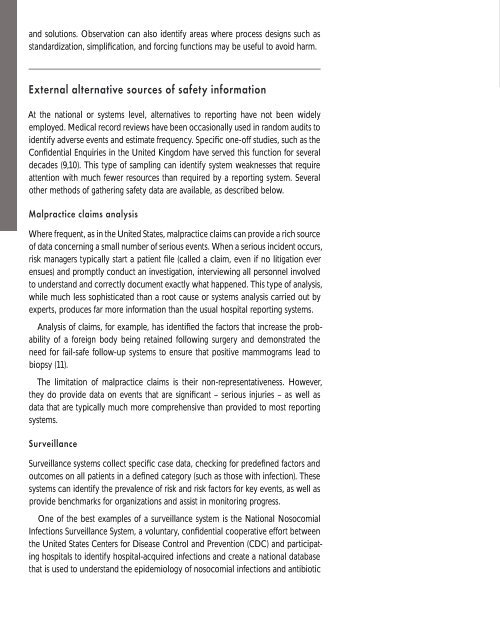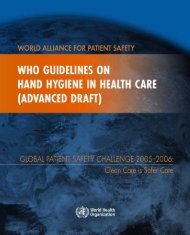Adverse event reporting.pdf
Adverse event reporting.pdf
Adverse event reporting.pdf
Create successful ePaper yourself
Turn your PDF publications into a flip-book with our unique Google optimized e-Paper software.
and solutions. Observation can also identify areas where process designs such as<br />
standardization, simplification, and forcing functions may be useful to avoid harm.<br />
External alternative sources of safety information<br />
At the national or systems level, alternatives to <strong>reporting</strong> have not been widely<br />
employed. Medical record reviews have been occasionally used in random audits to<br />
identify adverse <strong>event</strong>s and estimate frequency. Specific one-off studies, such as the<br />
Confidential Enquiries in the United Kingdom have served this function for several<br />
decades (9,10). This type of sampling can identify system weaknesses that require<br />
attention with much fewer resources than required by a <strong>reporting</strong> system. Several<br />
other methods of gathering safety data are available, as described below.<br />
Malpractice claims analysis<br />
Where frequent, as in the United States, malpractice claims can provide a rich source<br />
of data concerning a small number of serious <strong>event</strong>s. When a serious incident occurs,<br />
risk managers typically start a patient file (called a claim, even if no litigation ever<br />
ensues) and promptly conduct an investigation, interviewing all personnel involved<br />
to understand and correctly document exactly what happened. This type of analysis,<br />
while much less sophisticated than a root cause or systems analysis carried out by<br />
experts, produces far more information than the usual hospital <strong>reporting</strong> systems.<br />
Analysis of claims, for example, has identified the factors that increase the probability<br />
of a foreign body being retained following surgery and demonstrated the<br />
need for fail-safe follow-up systems to ensure that positive mammograms lead to<br />
biopsy (11).<br />
The limitation of malpractice claims is their non-representativeness. However,<br />
they do provide data on <strong>event</strong>s that are significant – serious injuries – as well as<br />
data that are typically much more comprehensive than provided to most <strong>reporting</strong><br />
systems.<br />
Surveillance<br />
Surveillance systems collect specific case data, checking for predefined factors and<br />
outcomes on all patients in a defined category (such as those with infection). These<br />
systems can identify the prevalence of risk and risk factors for key <strong>event</strong>s, as well as<br />
provide benchmarks for organizations and assist in monitoring progress.<br />
One of the best examples of a surveillance system is the National Nosocomial<br />
Infections Surveillance System, a voluntary, confidential cooperative effort between<br />
the United States Centers for Disease Control and Pr<strong>event</strong>ion (CDC) and participating<br />
hospitals to identify hospital-acquired infections and create a national database<br />
that is used to understand the epidemiology of nosocomial infections and antibiotic
















